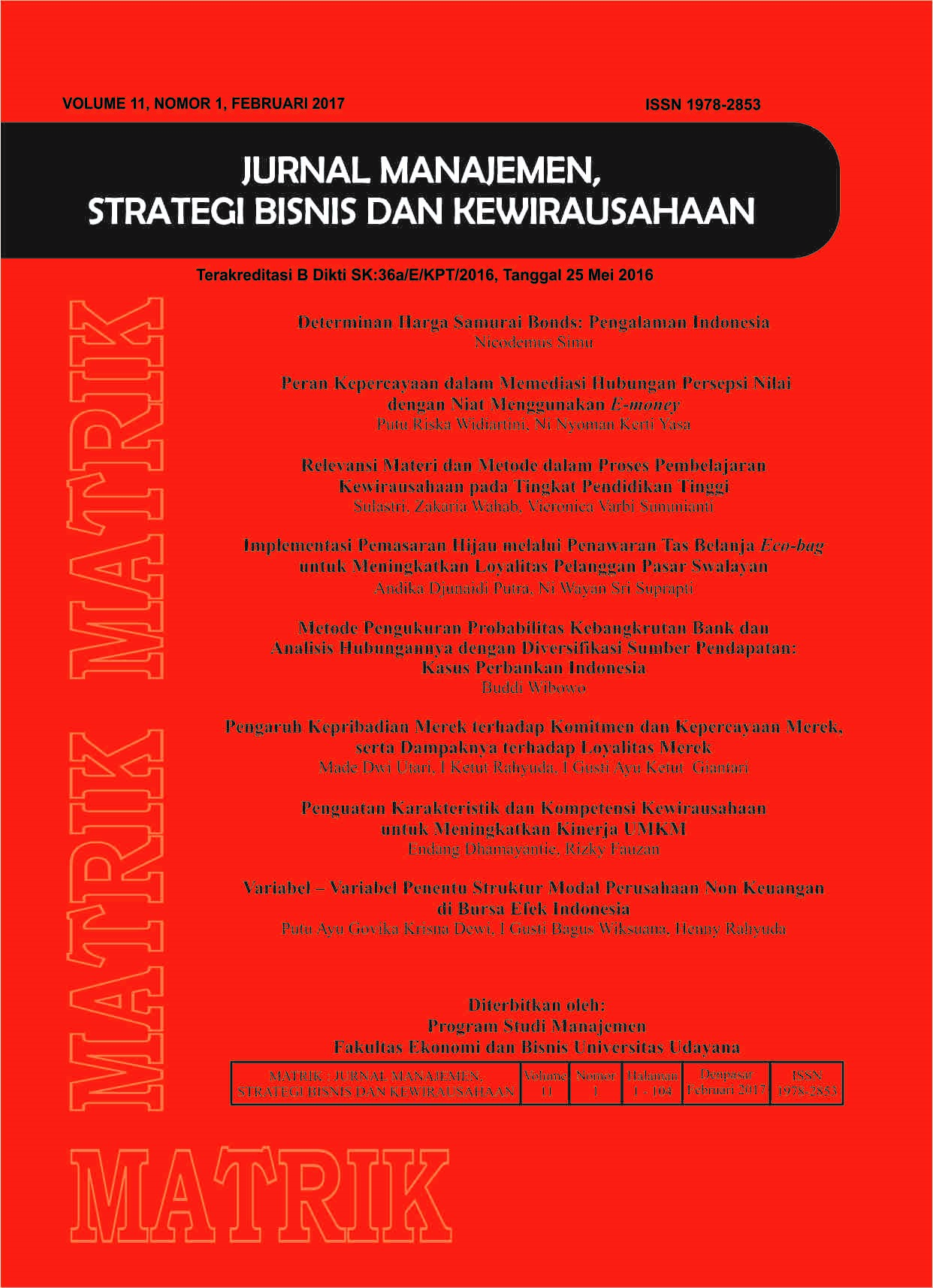METODE PENGUKURAN PROBABILITAS KEBANGKRUTAN BANK DAN ANALISIS HUBUNGANNYA DENGAN DIVERSIFIKASI SUMBER PENDAPATAN: KASUS PERBANKAN INDONESIA
Abstract
Abstrak
Metode pengukuran probabilita kebangkrutan bank adalah masalah riset klasik. Metode pengukuran menggunakan analisis diskriminan dan model logit seperti Altman’s Z score dan Model Ohlson tidak memiliki dasar teoretik keuangan yang memadai karena variable-variabel yang ada di dalam model dipilih secara arbitrer dan sangat tergantung pada data yang digunakan utuk mengestimasinya. Model Merton adalah model pengukuran probabilita default yang diakui secara luas sebagai model yang memiliki dasar teroretik yang kuat namun memiliki masalah tersendiri pada implementasinya karena variabel yang digunakannya bersifat unobservable. Probabilita default sendiri dipengaruhi oleh tingkat diversifikasi pendapatan bank. Beberapa riset menghasilkan kesimpulan yang bertentangan. Pada perbankan Indonesia hubungan antara kedua variable tersebut bersifat kuadaratik (U shape) dimana diversifikasi yang natural awalnya dapat menurunkan probabilita default bank, namun sampai suatu titik diversifikasi yang terlampau tinggi justru mendorong probabilita default menjadi naik.
Kata Kunci: Bank, Risiko, Probabilitas Kebangkrutan, Diversifikasi,
Abstract
Bank’s probability of default measurement method is one of the classic research problem. The measurement methods using discriminant analysis and logit models such as Altman's Z score and Ohlson Model do not have adequate financial theoretical foundation because variables in the models are chosen arbitrarily and depend heavily on the data used in estimation. Merton’s model of default probability is a measurement model that is widely recognized as a model that has a strong theoretical basis but has its own problems in its implementation because it uses unobservable variables. Default probability itself is influenced by the level of income diversification. Some research resulted in conflicting conclusions. We show that in Indonesian banking industry, relationship between these two variables are quadratic (U shape) which show natural diversification can reduce the bank’s probability of default, until reach a infelction point that too high diversification would encourage the probability of default to be increased
Key word: Bank, Risk, Probability of Default, Diversification
Downloads
References
Afik, Z., Arad, O.,& Galil, K .(2016). Using Merton model for default prediction: An empirical assessment of selected alternatives, Journal of Empirical Finance 35, 43–67
Altman, E. (1968). Financial Ratios, Discriminant Analysis and the Prediction of Corporate Bankruptcy. Journal of Finance, 189–209.
Anginer, D., Demirguc-Kunt, A., & Zhu, M. (2014). How does competition affect bank systemic risk? Journal of Financial Intermediation, 1-26.
Beaver, W. H. (1966). Market prices, financial ratios, and the prediction of failure. Journal of Accounting Research, 6(2), 179-182.
Beck, T., Jonghe, O. D., & Schepens, G. (2012). Bank competition and stability: Cross-country heterogeneity. Journal of Financial Intermediation, 218-244.
Berger, A N., Klapper, L., & Turk-Ariss, R. (2009). Bank Competition and Financial Stability, Journal of Financial Services Research, vol. 35(2), pages 99-118
Berger, A.N.(1995). The Relationship Between Capital and Earnings in Banking, Journal of Money, Credit and Banking, 27, 432-56.
Berger, A.N., Demirguc-Kunt, A., Levine, R., & Haubrich, J (2004), Bank concentration and competition: An evolution in the making, Journal of Money, Credit and Banking 36, 433-451.
Berger, A.N., R. DeYoung, M.J. Flannery, D. Lee, & Oztekin, O. (2008), How do large banking organizations manage their capital ratios?, Federal Reserve working paper.
Boyd, J., & De Nicolo, G (2005), The Theory of Bank Risk Taking Revisited, Journal of Finance 60, 1329-1343.
Boyd, J., G. De Nicolo, & A.M. Jalal, (2006), Bank risk taking and competition revisited: New Theory and Evidence, IMF Working paper, WP/06/297.
Carletti, E., & Hartmann, P. (2003), Competition and Financial Stability: What’s Special about Banking?, In Monetary History, Exchange Rates and Financial Markets: Essays in Honour of
Charles Goodhart, Vol. 2, edited by P. Mizen, Cheltenham, UK: Edward Elgar.
Carretta, A, V Farina, F Fiordelisi, P Schwizer, & F S Stentella Lopes (2015) Don’t Stand So Close to Me: The Role of Supervisory Style in Banking Stability, Journal of Banking & Finance Vol 52, p 180–188
Cavallo, L., & Rossi. S. (2001). Scale and Scope Economies in the European Banking systems, Journal of Multinational Management, Volume 11, Issues 4–5, 515–531
DeYoung, R., & Torna, G., (2013). Nontraditional Banking Activities and Bank Failures During the Financial Crisis. Journal of Financial Intermediation 22, 397–421.
Edmister, R. (1972). An Empirical Test of Financial Ratio Analysis for Small Business Failure Prediction, The Journal of Financial and Quantitative Analysis, Vol. 7, No. 2, 1477-1493
Feng, G. & Serlitis, A. (2010). Efficiency, Technical Change and Returns To Scale in Large U.S. Banks: Panel Data Evidence From an Output Distance Function Satisfying Theoretical Regularity. Journal of Banking and Finance, 34: 127-138.
Fernandez, A., Gonzalez, A., & Suarez, N. (2016). Banking Stability, Competition and Economic Volatility. Journal of Financial Stability 22, p 101-120
Fu, X., Lin, Y., & Molyneux, P.(2014)Bank Competition and Financial Stability in Asia Pacific, Journal of Banking & Finance Vol 38 Pages 64-77
Ferreira Filipe, S., et al., (2016) Pricing default risk: The good, the bad, and the anomaly. Journal of Financial Stability, http://dx.doi.org/10.1016/j.jfs.2016.07.001
Gujarati, D. and Porter, W (2008) Basic Econometrics, McGraw Hill 5 th edition, New York
Hadad, M., Santoso, W., & Sarwedi, B (2004) Model Prediksi Kepailitan Bank Umum di Indonesia, Bank Indonesia Research Paper, Direktorat Penelitian dan Peraturan Perbankan Bank Indonesia
Hellmann, Thomas, Kevin C. Murdock, and Joseph E. Stiglitz, (2000), Liberalization, Moral Hazard in Banking, and Prudential Regulation: Are Capital Requirements Enough? American Economic Review, 90 (1), 147-165
Hovakimian, A., Kayhan, A.& Titman, S. (2012).Are corporate default probabilities consistent with the static tradeoff theory? Review of Financial Studies, 2012, vol 25, No. 2, 315-340.
Keeley, M. (1990), Deposit Insurance, Risk and Market Power in Banking, American Economic Review, December, 1183-1200.
Lepetit, L., Nys, E., Rous, P., & Tarazi, A., (2008). Bank Income Structure And Risk: An Empirical Analysis of European Banks. Journal of Banking and Finance 32, 1452–1467.
Martin, D.,(1996) Early Warning of Bank Failure: A Logit Regression Approach, Journal of Banking and Finance, 249-276
Mercieca, S., Schaeck, K., & Wolfe, S.(2007). Small European banks: benefits from diversification? Journal of Banking and Finance 31, 1975–1998
Merton, R. (1974). On the pricing of corporate debt: the risk structure of interest rate. Journal of Finance, 449-470.
Meslier, C., Tacneng, R., & Tarazi, A. (2014) Is Bank Income Diversification Beneficial? Evidence From an Emerging Economy, Journal of International Financial Markets, Institutions and Money 31 97–126
Nguyen, M., Skully, M., & Perera, S., (2012). Market power, revenue diversification and bank stability: Evidence from selected SouthAsian countries. Journal of International Financial Markets, Institutions and Money 22, 897–912
Ohlson, J. A. (1980). Financial ratios and the probabilistic prediction of bankruptcy. Journal of Accounting Research, New York: 18(1), 109–131
Schaeck, K, Cihak, M., & Wolfe, S(2009), Are More Competitive Banking Systems More Stable?, Journal of Money, Credit and Banking, vol. 41(4), pages 711-734, 06
Stiglitz, J.E., & Weiss, A, (1981).Credit Rationing in Markets With Imperfect Information, American Economic Review , Vol. 71, 393-410.
Stiroh, K.J.(2006). New Evidence On The Determinants of Bank Risk. Journal of Financial Service Research 30, 237–263.
Stiroh, K.J., & Rumble, A. (2006). The Dark Side of Diversification: The Case of U.S. Financial Holding Companies. Journal of Banking and Finance 30, 2131–2161.
Sundaresan, S., 2013. A Review of Mertons Model of the Firms Capital Structure with itsWide Applications. Annual Review of Financial Economics, 5, 21–41.
Taffler, R J. (1982). Forecasting Company Failure in the UK Using Discriminant Analysis and Financial Ratio Data, Journal of the Royal Statistical Society. Series A, Vol. 145, No. 3, 342-358
Taylor, W E. (1980) Small Sample considerations in the estimation from Panel Data, Journal of Econometrics, vol 13, p 203-223
Wooldridge, J (2012) Econometric Analysis of Cross Section and Panel Data, Massachussetts Institute of Technology, p 251 -252
Keywords
 This work is licensed under a Creative Commons Attribution-ShareAlike 4.0 International License.
This work is licensed under a Creative Commons Attribution-ShareAlike 4.0 International License.

















